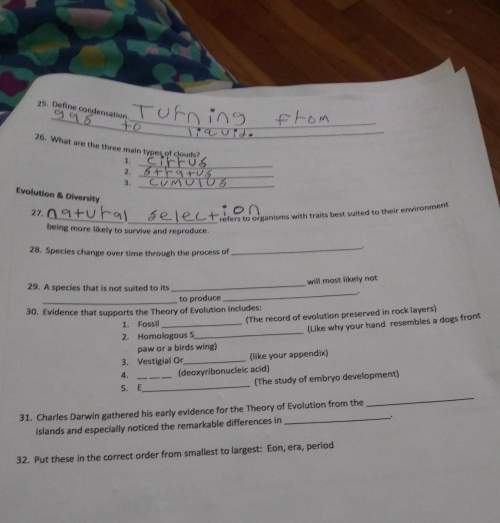
PLEASE HELP THIS IS FOR A FINAL
(NO LINKS PLEASE)
A solar array (containing 225 panels) at DIA converts light energy to electric potential energy with an efficiency of 28%. How much electric potential energy can be produced by the array each day of 33,000 J of energy reach each solar panel?

Answers: 2


Another question on Physics

Physics, 21.06.2019 22:00
There is a theory that indicates that dinosaurs became extinct when about 65 million years ago, a large asteroid hit the earth surface. dust caused by this collision blocked the sunlight reaching the earth's surface and many forms of life became extinct due to the cold. fearing this threat, how large the radius of an asteroid should you be looking for if the dangerous asteroid size is approximately the same as the one that killed the dinosaurs? available data suggests that about 18% of that asteroid's mass ended up as a dust spread evenly over earth after eventually settling out of the upper atmosphere. about 0.0180 g/cm^2 of dust, which is chemically different than the earth's rock, covered the earth's surface. typical asteroids have a density of about 1.9 g/cm^3. now that we know the size of the asteroid, how much energy was released during impact, assuming all of it was just the kinetic energy of the asteroid right before the impact?
Answers: 1

Physics, 21.06.2019 23:00
Acoal-fired plant generates 600 mw of electric power. the plant uses 4.8 x 10^6 kg of coal each day, and the heat of combustion of coal is 3.3x 10^7 j/kg. the steam that drives the turbines is at a temperature of 300° c, and the exhaust water is at 37° c. (a) what is the overall efficiency of the plant for generating electric power? (b) how much thermal energy is exhausted each day? (c) what is the change in entropy of the universe for this heat engine? (d) using the same heat reservoirs, what is the maximum possible (carnot) efficiency for a heat engine?
Answers: 1

Physics, 22.06.2019 00:10
The energy released by a chemical reaction can be measured using a calorimeter. when barium hydroxide octahydrate crystals are reacted with dry ammonium chloride inside of a coffee cup calorimeter, the temperature of the 18.00 g of water in the calorimeter decreases from 30.0°c to 8.0°c. the equation for calculating energy absorbed or released by a reaction is: where q is the energy released or absorbed, m is the mass of water in the calorimeter, cp is the specific heat of water, and δt is the observed temperature change. if the specific heat of liquid water is 4.19 j/g·°c, how much energy was absorbed by the reaction?
Answers: 3

Physics, 22.06.2019 05:30
The volume of a gas is halved during an adiabatic compression that increases the pressure by a factor of 2.5. what is the specific heat ratio? show the math steps .
Answers: 3
You know the right answer?
PLEASE HELP THIS IS FOR A FINAL
(NO LINKS PLEASE)
A solar array (containing 225 panels...
A solar array (containing 225 panels...
Questions














Engineering, 03.01.2020 06:31









